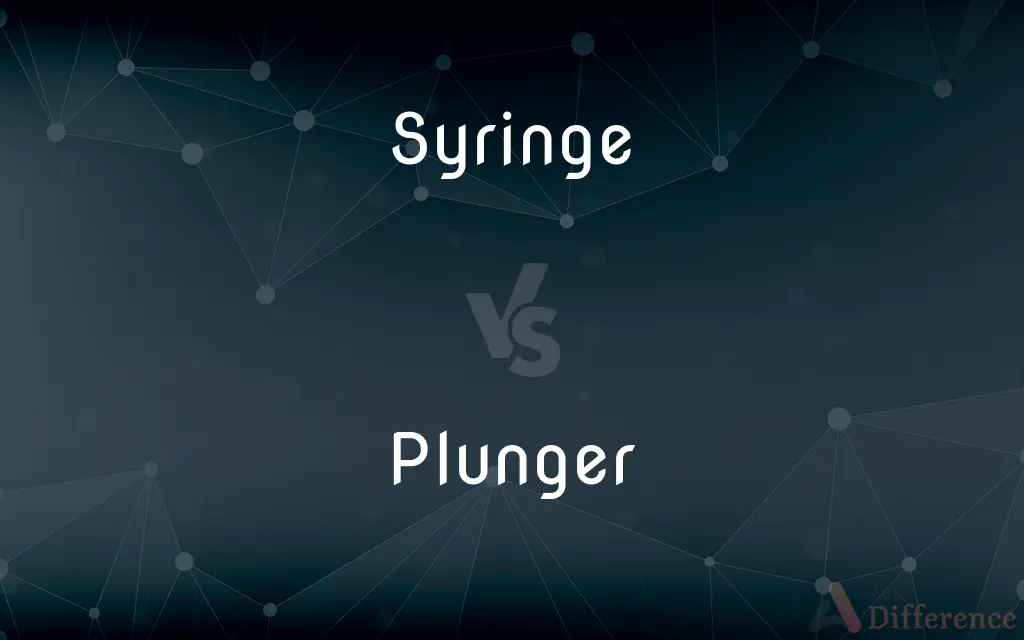Syringe vs. Plunger — What's the Difference?
By Maham Liaqat & Fiza Rafique — Updated on April 6, 2024
A syringe is a medical device for injecting fluids into or withdrawing them from the body, while a plunger is a part of a syringe that pushes or pulls the fluid through the syringe's barrel.

Difference Between Syringe and Plunger
Table of Contents
ADVERTISEMENT
Key Differences
A syringe is an instrument used in medical settings to inject substances into the body or extract fluids from it. It comprises several parts, including a barrel, a needle, and a plunger. On the other hand, the plunger is a specific component of the syringe, designed to slide smoothly within the barrel to either draw in or expel liquids, making it essential for the syringe's operation.
While the syringe as a whole is crucial for various medical procedures, vaccinations, and treatments, the plunger's role is focused on controlling the flow of fluids. This control is vital for accurate dosages and the effectiveness of injections or fluid withdrawal, illustrating the interdependence of the syringe's components for its functionality.
The design of a syringe is aimed at ensuring sterility and precision in medical applications, featuring a clear barrel for monitoring the substance and measuring marks for dosage accuracy. Meanwhile, the plunger is specifically designed to create an airtight seal within the barrel, allowing for precise control over the movement of fluids, which is crucial for both injecting and withdrawing fluids accurately.
In terms of materials, syringes can be made from plastic or glass, and are often disposable to maintain hygiene standards. Plungers, being part of the syringe, are typically made from materials that ensure durability and compatibility with the barrel, such as rubber or silicone, to maintain an effective seal and smooth operation.
The functionality of a syringe extends beyond medical injections; it includes applications in laboratories for measuring and transferring liquids with precision. In contrast, the plunger's function remains constant, acting as the mechanism that facilitates the syringe's operation, whether for medical injections, fluid withdrawal, or laboratory use.
ADVERTISEMENT
Comparison Chart
Purpose
Injecting or withdrawing fluids
Pushing or pulling fluid through the barrel
Components
Barrel, needle, plunger
Part of the syringe
Design Focus
Sterility, precision, dosage accuracy
Airtight seal, smooth operation
Material
Plastic or glass
Rubber or silicone
Functionality
Medical injections, laboratory use
Facilitates syringe operation
Compare with Definitions
Syringe
Includes a barrel, needle, and plunger.
The syringe's plunger was smoothly pulled to draw in the medicine.
Plunger
Controls the flow of fluids in the syringe.
The precise control of the plunger allowed for accurate dosing.
Syringe
Vital for medical procedures and laboratory measurements.
The laboratory technician used a syringe to measure the reagent precisely.
Plunger
The part of a syringe that moves fluid.
He carefully pushed the plunger to inject the vaccine.
Syringe
A device for injecting or withdrawing fluids.
The nurse prepared the syringe for the patient's injection.
Plunger
Creates an airtight seal within the barrel.
The plunger's seal ensured no liquid was lost during the procedure.
Syringe
Features clear markings for dosage accuracy.
The doctor checked the syringe's markings before administering the dose.
Plunger
Essential for the syringe's operation.
Without the plunger, the syringe cannot function effectively.
Syringe
Often made from disposable plastic.
Disposable syringes are used to ensure hygiene in medical procedures.
Plunger
Made from rubber or silicone for durability.
The silicone plunger moved smoothly in the syringe.
Syringe
A syringe is a simple reciprocating pump consisting of a plunger (though in modern syringes, it is actually a piston) that fits tightly within a cylindrical tube called a barrel. The plunger can be linearly pulled and pushed along the inside of the tube, allowing the syringe to take in and expel liquid or gas through a discharge orifice at the front (open) end of the tube.
Plunger
A plunger, force cup, plumber's friend or plumber's helper is a tool used to clear blockages in drains and pipes. It consists of a rubber suction cup attached to a stick (shaft) usually made of wood or plastic.
Syringe
A medical instrument used to inject fluids into the body or draw them from it.
Plunger
One who plunges or dives.
Syringe
A hypodermic syringe.
Plunger
A device consisting of a rubber suction cup attached to the end of a stick, used to unclog drains and pipes. Also called plumber's helper.
Syringe
A device used for injecting or drawing fluids through a membrane.
Plunger
A part of a machine, tool, or device that operates wtih a thrusting or plunging movement, such as a piston.
Syringe
A device consisting of a hypodermic needle, a chamber for containing liquids, and a piston for applying pressure (to inject) or reducing pressure (to draw); a hypodermic syringe.
Plunger
A device that is used to remove blockages from the drain of a basin or tub, by suction.
Syringe
To clean or rinse by means of a syringe.
Have your ears syringed! They're so dirty!
Plunger
The internal piece of a syringe that pushes out or pulls in any contents.
Syringe
To inject by means of a syringe.
Plunger
The sliding activator of an exploder, an electrical generator used to trigger electrical detonators such as blasting caps.
Syringe
A kind of small hand-pump for throwing a stream of liquid, or for purposes of aspiration. It consists of a small cylindrical barrel and piston, or a bulb of soft elastic material, with or without valves, and with a nozzle which is sometimes at the end of a flexible tube; - used for injecting animal bodies, cleansing wounds, etc.
Plunger
The part of a cafetière that is pushed down to remove grounds from coffee.
Syringe
To inject by means of a syringe; as, to syringe warm water into a vein.
Plunger
One who plunges; a diver.
Syringe
To wash and clean by injection from a syringe.
Plunger
A horse that plunges, or throws itself suddenly forward.
Syringe
A medical instrument used to inject or withdraw fluids
Plunger
(military) A cavalryman.
Syringe
Spray or irrigate (a body part) with a syringe
Plunger
A device similar to a piston but without a mechanism; a long solid cylinder used, instead of a piston or bucket, as a forcer in pumps.
Plunger
The moving portion of a solenoid.
Plunger
(pinball) The spring-loaded assembly that propels the ball onto the table.
Plunger
A reckless gambler or gamble.
Plunger
(pottery) A boiler in which clay is beaten by a wheel to a creamy consistency.
Plunger
(firearms) The firing pin of a breechloader.
Plunger
One who, or that which, plunges; a diver.
Plunger
A long solid cylinder, used, instead of a piston or bucket, as a forcer in pumps.
Plunger
One who bets heavily and recklessly on a race; a reckless speculator.
Plunger
A boiler in which clay is beaten by a wheel to a creamy consistence.
Plunger
The firing pin of a breechloader.
Plunger
Someone who risks losses for the possibility of considerable gains
Plunger
Someone who dives (into water)
Plunger
Hand tool consisting of a stick with a rubber suction cup at one end; used to clean clogged drains
Plunger
Mechanical device that has a plunging or thrusting motion
Common Curiosities
What is a syringe?
A syringe is a medical device used for injecting substances into or withdrawing them from the body.
What is a plunger?
A plunger is a component of a syringe that allows for the movement of fluids by creating an airtight seal within the barrel.
What materials are used to make plungers?
Plungers are typically made from materials like rubber or silicone to ensure durability and a proper seal.
How does the plunger function in a syringe?
The plunger functions by sliding within the syringe's barrel, allowing it to draw in or expel fluids accurately.
Are there different types of syringes?
Yes, there are various types of syringes designed for different medical and laboratory applications, such as insulin syringes, tuberculin syringes, and others.
What are the safety measures when using a syringe?
Safety measures include using a new, sterile syringe for each injection, proper handling to avoid needle-stick injuries, and correct disposal after use.
How does a plunger contribute to medication dosage accuracy?
The plunger's smooth and precise movement allows healthcare providers to administer exact dosages as required.
How do you ensure the sterility of a syringe?
Syringes are usually sterilized by the manufacturer and should be kept in their sealed packaging until use.
How do professionals dispose of used syringes?
Used syringes are disposed of in designated sharps containers to prevent needle-stick injuries and maintain public health safety.
Can syringes be reused?
For hygiene and safety reasons, most medical syringes are designed to be disposable and should not be reused.
What is the significance of the markings on a syringe?
The markings on a syringe allow for accurate measurement and dosing of the fluid being injected or withdrawn.
Is the plunger interchangeable between syringes?
Plungers are typically specific to their syringe to ensure a proper fit and seal, so they are not universally interchangeable.
What factors influence the choice of syringe for a procedure?
Factors include the type and volume of substance, the required precision, and the specific medical or laboratory needs.
How does the design of the plunger affect syringe usability?
A well-designed plunger ensures ease of use, accurate fluid control, and minimizes the risk of leakage or air bubbles, enhancing the overall effectiveness of the syringe.
Can syringes be used without a needle?
Yes, syringes can be used without a needle for purposes like feeding tube administration or oral medication.
Share Your Discovery

Previous Comparison
Blockade vs. Blockage
Next Comparison
Sulfobetaine vs. BetaineAuthor Spotlight
Written by
Maham LiaqatCo-written by
Fiza RafiqueFiza Rafique is a skilled content writer at AskDifference.com, where she meticulously refines and enhances written pieces. Drawing from her vast editorial expertise, Fiza ensures clarity, accuracy, and precision in every article. Passionate about language, she continually seeks to elevate the quality of content for readers worldwide.














































